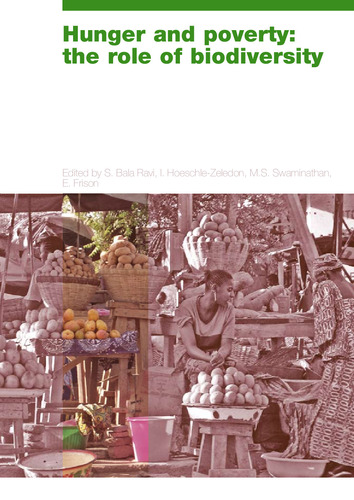Hunger and poverty: the role of biodiversity: Report of an International Consultation on the Role of Biodiversity in Achieving the UN Millennium Development Goal of Freedom from Hunger and Poverty, Chennai, India, April 18-19, 2005
Agricultural biodiversity plays a central role in household food security and income generation, and thus in achieving Millennium Development Goal (MDG) 1 of halving the proportion of hungry and extremely poor people by 2015. However, its wider use to address nutritional deficiencies and other aspects of poverty, all of paramount importance, is yet to be fully realized. With this in mind, an International Consultation was held in Chennai, India, in April 2005, gathering together policy-makers and experts with diverse backgrounds from 25 countries. The aim of the Chennai consultation was to emphasize the unique contribution that agricultural biodiversity makes to improved livelihoods, through providing a foundation for household food and nutrition security and offering opportunities for income generation. Agriculture is what feeds us but agricultural biodiversity is what sustains us. The consultation also looked at policies, institutional constraints and other issues that are impeding the full deployment of these natural resources and hence limiting the achievement of the MDGs. Concern was registered at the rapid loss of these resources, which seriously threatens the food and nutrition security of future generations. This report documents the presentations made at the consultation and the papers contributed, the discussions conducted thereon, the outputs of the working groups and the final recommendations.The principal outcome of the consultation was the adoption of the Chennai Platform for Action, which was drawn up with serious commitment on the part of all present to address the value of agricultural biodiversity in meeting the MDGs. This is a 10-point strategy, designed to assist national governments and international agencies to achieve, as soon as possible, the UN MDG of halving extreme poverty and hunger by 2015. This can be done through the promotion of local, community-centered systems that will deliver improved food security and health, based on the cultivation of a wide range of food crops, vegetables, fruits and medicinal plants. The Chennai Platform for Action is available as a separate publication in seven languages to facilitate action and awareness generation by different stakeholders. It is hoped that this action plan will be widely adopted because the eradication - and not mere reduction - of hunger and poverty must become an overriding priority for public action and investment. Moreover, the challenge of the MDGs is not simply to halve hunger but also to attack the hidden hunger caused by unbalanced diets, and to do so in a sustainable manner. In the past, approaches to hidden hunger were essentially based on supplementation and fortification. However, such remedies do not address all aspects of malnutrition and have not proved feasible in all circumstances, particularly for the rural poor. Therefore, the dietary diversity approach is really the main way forward. We must bear in mind that the right to food is the right to 'good' or 'adequate' food. The global struggle against poverty and hunger cannot be won without increased collaboration in the conservation, and sustainable and fair use of agricultural biodiversity. Genetic diversity is the foundation of all improvements to agriculture. Diversity can also help improve productivity by raising yield stability, contributing to pest and disease control, and improving the environment. Meeting the Millennium Development Goals will require political will, financial commitment and a readiness to attempt innovative solutions. The very fact that five years after the adoption of these goals, most developing countries have been unable to make proportionate progress in the elimination of hunger and poverty indicates the need for an overall change in the manner in which we have addressed this challenge to date. Without such a change we will not achieve the goal of a hungerfree world. Let us keep before our eyes a positive reality: that, given the necessary resources and collaboration, the MDGs can, in fact, be achieved. In a world where 852 million people are hungry, in the words of FAO Director-General, Jacques Diouf, ”The question is not whether we can afford to take the urgent and immediate action needed...The question is whether we can afford not to.1” Can we have a hunger-free world? This is the challenge. 1The State of Food Insecurity in the World 2004, FAO, Roma, 2004

